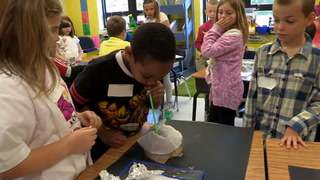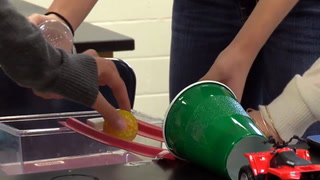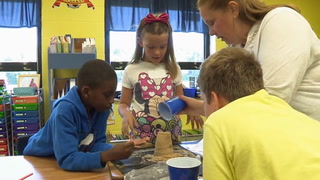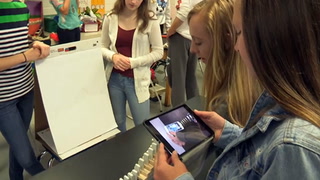Energy & Matter Across Science Disciplines Transcript
Trisha Shelton: Welcome everyone. I'm so excited to see all of your designs today and to hear your amazing thinking. We're going to start the video explanation portion or our Rube Goldberg.
You want to create a video explanation that explains your device.
My name is Trisha Shelton. I am a science teacher in Boone County, Kentucky. I have been teaching high school science for 20 years. I teach anatomy and physiology, integrated science and biology.
Included in your explanation should be one run of your entire machine. All right. Good luck.
Speaker 2: We've been learning about transfers of energy. At first we started learning about food chains and ecosystems and how energy transfers through there. Then, threw a curveball into it and now it's all life science. She threw a curveball into it and added physical science into it.
Trisha: We have been focused on a study of the conservation and flow of matter and energy within a life science system. The students expressed an interest in incorporating a Rube Goldberg a couple of months ago, actually. This became our opportunity when we were studying the life science system, for us to transfer that to a physical science system. The umbrella, so to speak, for our class, has been the cross-cutting concept of energy.
Today we built a Rube Goldberg machine to understand energy transfers and how that works.
We were moving back and forth between a physical and a life science system throughout the day while we were deepening our understanding of the conservation of energy and applying a new situation of discussing efficiency.
Students really need to have an understanding of how to communicate evidence based thinking. That is something that, from day one, we have tried to develop that seed.
Speaker 3: As the objects interact with each other, it really just transfers the energy and it causes a series of events to unfold.
Speaker 4: When it hits the car, that's a transfer of energy. It goes from the dominoes to the car, the kinetic energy transfers. That was awesome.
Speaker 5: The Jingo blocks aren't transferring energy enough to knock the next car all the way over.
Trisha: What are you guys doing to try to make the energy exchange happen more efficiently?
Speaker 4: Well, when the marble was hitting it, it had more outward thrust this way. There were more Newtons coming out this way, so the marble would [crosstalk]-
Trisha: If you let them explore before you explain -
Speaker 4: - but if you have it this way, where it was bent forward like this, there's more thrust going out to the backside [crosstalk]-
Trisha: - and then making sure that you are making the cross-cutting concepts explicit in the classroom because those are the tools that allow students to get to independent thinking.
Okay, ladies and gentlemen. You guys had some fantastic table talk around the core ideas that you used to build your design, how you fixed the problems that you ran into, your understanding of energy and your use of models and engineering design.
We use that deeper understanding and then transferred it back to the life science system where this week they designed an organism that they could make a claim that it was the most efficient source of energy for a human. They had to be able to describe or express the ecosystem that that organism would be a component of.
We're going to transition from a physical science system to a life science system that you guys have been studying. One at a time, you're going to defend the claim "My organism is the most efficient source of energy for the human." Your claim, what we're looking for is that your claim is based on evidence from your design. Your claim should also reflect the scientific knowledge of both of our systems under study. The Rube as well as the ecosystem and then your peers that are sitting with you today are going to respectfully provide critique by probing your reasoning, asking you questions and challenging your ideas. All right. Good luck.
Speaker 6: Whatever's at the top of the Food Chain takes in the most energy and the most biomass because it eats what other things eat. So if a human were to eat whatever was at the top of the Food Chain, we would then get the most energy.
Speaker 7: I looked at this from a different perspective of [?] and I don't know if that's a good thing or a bad thing but then I thought of an efficient organism, I was thinking "What's an animal that we've been eating since the dawn of time and it's easy to catch?" The first thing that came to mind was fish. That's what I thought of when I thought of an efficient organism or an efficient source of energy.
Speaker 6: I can totally see where you're coming from. WeΓÇÖve all been thinking what to say is the better choice and we come together as a group to form the best answer. If I say this is my opinion and that's all I say, they can't agree with me just because I say so. I have to be able to tell them, "I think this is it because," "Here's all the evidence that I have to prove for it," and then maybe another person in my group would be like, "I don't think so and here's why."
Speaker 8: What I liked about yours was how you showed the transfer from the sun, which has 100 percent to ten.
Speaker 9: Yeah, like how low the amount of energy that transferred gets.
Speaker 10: There's no [?] relationship that they have to waste energy on. They just have to eat grass. That seems like a lot of ways in which it could save on energy. But I can't find out a way to quantify that. [crosstalk]
Trisha: When students communicate with evidence in my classroom and when they are evaluating the evidence that other students are communicating to the group, they look to see if the evidence is sufficient, if it is reliable, if it is in their minds complete and so one of the things that they look for a lot is if the evidence is quantitative.
Speaker 11: We really need to work on quantifying how much energy is being taken in and where it gets dispersed transferred to the next.
Speaker 12: It's total energy output is .75 and daily it ingests .8.
Speaker 13: So it doesn't have as much energy as the pig.
Speaker 12: Yeah. It doesn't offer as much to us.
I quantified my model and my other group members didn't. They had the pig without numbers and I had the pig with numbers.
Speaker 13: It relates less heat a day and less waste, so that means it doesn't have as much energy to give.
Speaker 12: Yeah, exactly.
Trisha: If I can interrupt you, ladies and gentlemen, for just a second. What we need to hear is your groups claim about how the life science system and the physical science system are alike and different. I told this group I was going to let them start so I'm going to hand it over to Felicity.
Felicity: Okay, so we compared and contrasted the two ecosystems.
Trisha: [crosstalk] I think that the small changes that led to big changes, over time, in our class, is the focus on evidence based thinking because that opens the door for more participation.
Felicity: We know that as energy transfers in animals, some is lost due to the cellular respiration. As the animals go on in Ecosystem A, more and more energy is lost. We figured out that it works the same with the Rube Goldberg because if we had too many steps in our Rube Goldberg we would lose too much energy and it wouldn't finish. If we had less steps then there's enough energy to make it all the way through the system without it not completing.
Speaker 10: We had the same thing going on in our Rube Goldberg machine when we saw that we had a cardboard tube in which the marble was supposed to roll down. And we realized that was losing too much energy due to friction and [crosstalk]-
Trisha: Students want to share to the conversation. They want what they are saying to be valued and to be important. If they know that they can look for evidence and then use that evidence to communicate their reasoning, in their lens, that makes science very accessible to them and it makes the class participation very accessible to them.
That was great piggybacking off one another to all, and then we got to this big idea that we experienced. Do you feel like "I got this now. I have this understanding that I can transfer." That was a lot of thinking. You guys had a lot of conversation to get to that point. That is the great benefit of table talk and sharing your claims with other people and having that trust. Thank you guys so much for that.
Speaker 14: I never would have thought that what we were learning about in photosynthesis would correlate to how a marble rolls down a track.
Speaker 15: We don't do what we do in this class in a whole bunch of other classes. It asks us why. Why is that the correct answer? I think that's what helps us understand more because it's not just like "Here, there's the answer." It makes us be like, "The answer is this because." And you pull out all your evidence and you pull out your reasoning. It makes us think.














10 Comments
Megan Bartley Mar 16, 2019 10:25pm
Has anyone here tried to use the energy storage and transfer model with bar charts? It would really enrich this activity with a shared representational strategy.
Gretchen Vierstra Sep 22, 2017 3:59pm
Wendy Manson Sep 21, 2017 3:38pm
Gretchen Vierstra Sep 21, 2017 12:56pm
Wendy Manson Sep 21, 2017 12:42pm